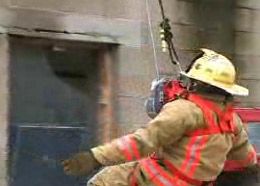By Jamie Thompson
FireRescue1 Editor
 Image courtesy of Life-Pack Technologies A firefighter uses Bailout Buddy during a demonstration day. |
Bailing out of a window from a burning building is one of the most dramatic — and difficult — challenges a firefighter can face.
A new escape system, the Bailout Buddy, aims to make the process much easier. Requiring only minimal training, its hands-free design will allow the user to take a civilian or fellow firefighter to safety with them.
Among the unique selling points of the device, made by Southeastern Pennsylvania-based Life-Pack Technologies, is its 40 feet of high-strength steel cable, as opposed to the more traditional rope, and its hands-free design.
Steven Jacobs, chief operating officer of the company, said the cable and the built in force limiter enables the system to carry more weight — such as another person — and withstand much higher temperatures.
“Rope systems can lose tremendous strength above 500 F and turn to powder at 930 F,” Jacobs said, “but a steel cable can withstand temperatures greater than 1,000 F.”
Life-Pack Technologies was founded by Robert Leon, a life-long entrepreneur and inventor, in the wake of the 9/11 attacks on the World Trade Center.
After seeing on TV the images of people leaping to their deaths from the upper floors of the Twin Towers, he designed the “Life-Pack,” a controlled descent backpack device. It contains a steel cable long enough to reach the ground from up to 110 stories, with a clip that attaches to an adjacent anchor box by the evacuation window.
Firefighter input
The technology was noted by fire service safety leaders, who asked whether it could be adapted to suit the needs of firefighters. These requests prompted Leon to design the Bailout Buddy.
Bailout Buddy is far less bulky than the civilian device and can easily be worn with turnout gear. While the steel cable is much shorter, it will allow the firefighter to descend to a lower floor window away from the fire. An internal cable-force limiter absorbs up to a 3-foot initial freefall with up to 500 lbs, and the cable automatically rewinds to eliminate slack.
“The cable-force limiter allows you to place the hook into the windowsill, the wall next to the window or pipes close to the window and literally dive out of the window,” Jacobs said. “Even after a freefall, within a fraction of a second, it lowers you down at a rate of 3 to 4 feet per second.”
The system attracted a lot of interest at the company’s booth at FDIC in Indianapolis this year, Jacobs said, particularly because of its ease of use and minimal training requirement.
“We aimed to design it so you could wear it comfortably and not have to worry about it,” he said. “But it you get in a situation where you need to use it, then it can be easily deployed as it’s a purely mechanical device and you —and someone else — can get out safely.”
The company designed the system, Jacobs said, to be amazingly simple to use. As for training, “You literally only need familiarization training to be comfortable using it when jumping out of the window,” he said.
Bailout Buddy is a single-use device, with the company offering free lifetime replacements as part of its “Buddy for Life” program. It goes on the market in September 2008.

